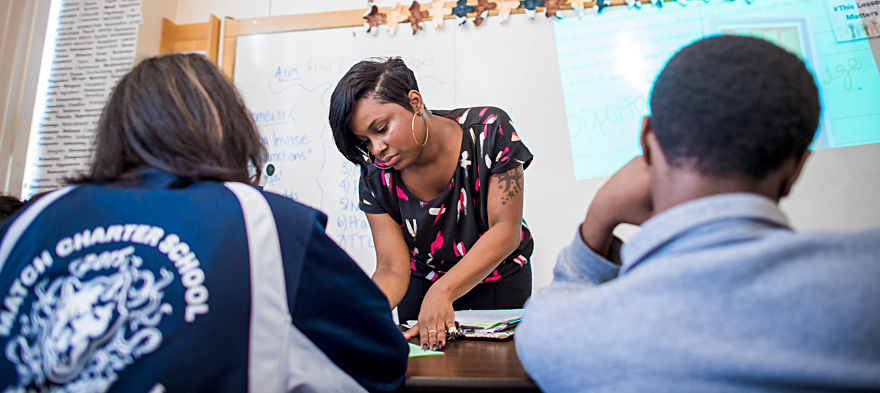
Jun 23, 2021 12:00:00 AM
by Ashley Davis
All children deserve a good education, but too many of them do not receive one. Unsurprisingly, students who are most likely to attend under-resourced schools with underprepared teachers are poor, Black and brown. It is a situation that has stagnated for decades, but now the U.S. is at a reckoning point where our Black and brown school-aged children outnumber white school-aged children nationally.
However, teacher demographics are not diversifying at remotely the same pace. If we believe that all children deserve a good education, then we must make an honest effort to recruit and train more Black and brown teachers to serve—and represent—these chronically disenfranchised populations.
Research shows Black and brown students not only fare better academically when they have teachers from the same race or cultural background, they also feel seen, heard, and represented at an institutional level. As school principals and teachers of color, we understand the meaningful connections forged when we can talk to students about the best braiding salon or about what it meant to see Amanda Gorman recite her poem at President Biden’s inauguration, or talking with their families about the challenges of raising their children in a white-dominated world.
Last year, classrooms across the country were buzzing with candid discussions on race when Black Lives Matter protests rose up in the wake of George Floyd’s murder. [pullquote]Both Black and white students were engaged, with conversations about race sprouting organically almost every day. This is exceedingly rare.[/pullquote]
Typically, school conversations about racism are limited to Black History Month or Martin Luther King, Jr.’s birthday. Having this shared experience was a “scales fall from the eyes” moment for many white students and teachers, one that should inform and codify an anti-racism curriculum going forward, 12 months of the year. But, if we are to be successful, we’re going to need more Black and brown teachers, not to mention administrators and superintendents.
Teachers of color tend to provide more culturally-relevant teaching and better understand the situations that students of color may face. When students open their textbooks, they often see white faces staring back at them. The authors they are assigned to read are also predominantly white. A teacher of color may be more likely to mix up that reading list and introduce students to Toni Morrison, for instance. And, [pullquote position="right"]a wider perspective benefits all students.[/pullquote] White students report feeling challenged and cared for by their teachers of color and found they gained a deeper level of appreciation for people of different races and backgrounds.
If we are to diversify our teacher base, we need to start by recruiting more Black and brown people to our training programs and schools. Both of us attended The Charles Sposato Graduate School of Education, a school that constantly reinforced the message that we must never lower our expectations for our students. This is especially important if a teacher one day lands in a school district with mostly Black and brown students. Schools, especially ones with predominantly white teachers and administrators, can easily fall into the trap of thinking paternalistically about “saving” students or “knowing what’s best for them.” This is classic coded language for teaching students to assimilate to white supremacy culture.
While at Sposato, we also learned how to have difficult conversations and accept feedback on our performance without becoming defensive. Defensiveness is also a tenet of white supremacy, so being able to accept feedback is huge. After the BLM protests last year, many schools shared statements of solidarity, but [pullquote]we will need to have difficult conversations going forward if we are to sustain an anti-racism culture across our educational landscape.[/pullquote]
So, let’s talk about how we can meet this moment:
Dismantling white supremacy is a huge feat for all institutions and is lifelong work. Ultimately, the responsibility of a teacher is to meet the needs of all students and provide them with the education they deserve. If schools create more opportunities for reflection and ensure every student is represented, it would be a big step forward on this long road to equality.
Ashley Davis has led Boston Public Schools’ Pauline A. Shaw Elementary School as principal since spring 2019. Ahead of becoming a full-time principal, she participated in Boston College’s Lynch Leadership Academy as an aspiring principal fellow. Prior, she earned a master’s in effective teaching from The Charles Sposato Graduate School of Education, after which she taught ninth grade English at Match Charter Public School for six years. She holds a bachelor's degree in English Literature from Kentucky State University.
Few issues in education spark more tension and debate than standardized testing. Are they a tool for equity or a burden on students? A necessary check on school systems or a flawed measure of...
Charter schools are public schools with a purpose. Operating independently from traditional school districts, they're tuition-free, open to all students, and publicly funded—but with more flexibility...
Despite the benefits of a diverse teaching force, prospective teachers of color fall out of our leaky preparation pipeline at every stage: preparation, hiring, induction, and retention. Here’s what...
Ed Post is the flagship website platform of brightbeam, a 501(c3) network of education activists and influencers demanding a better education and a brighter future for every child.
© 2020-2025 brightbeam. All rights reserved.
Leave a Comment